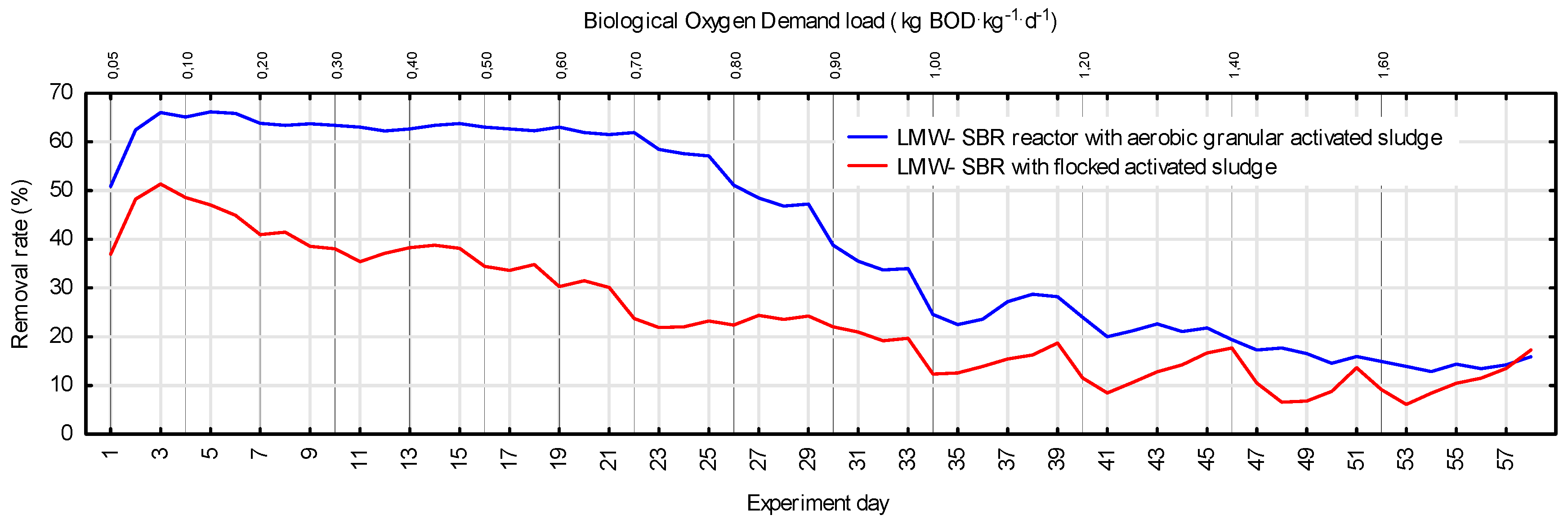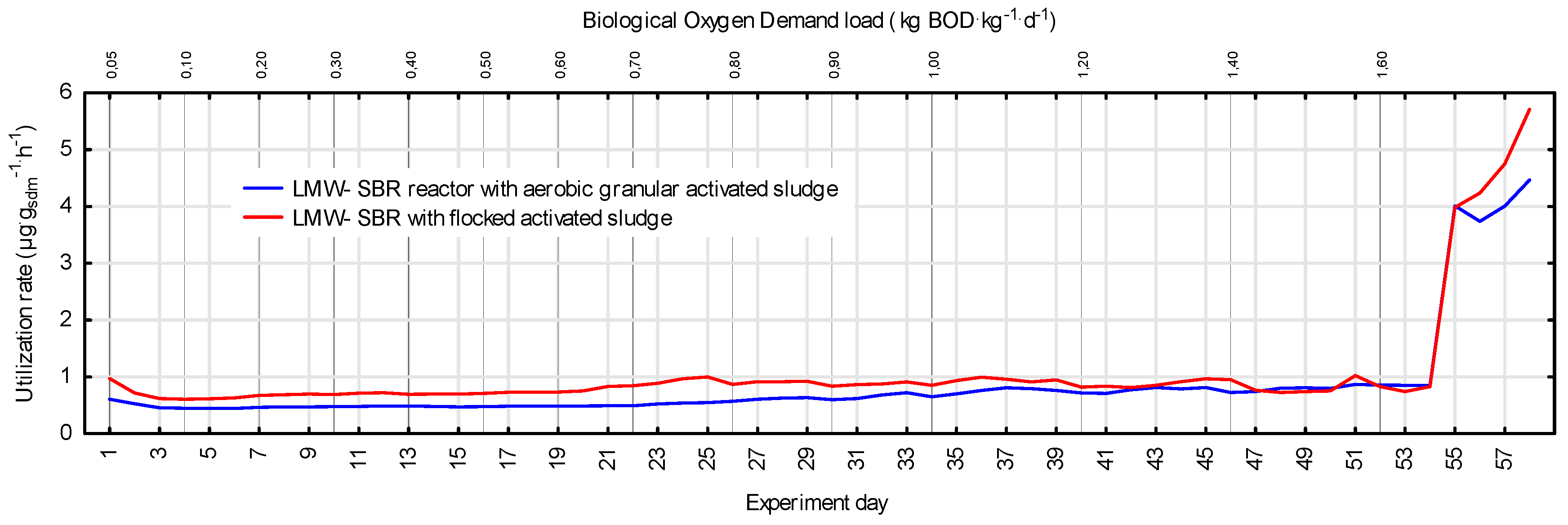Comparison of ΣLMW Utilization Rate from Saline Wastewater in SBR Reactors with Granular and Flocked Activated Sludge †
Abstract
:1. Introduction
2. Materials and Methods
3. Results and Discussion
5. Conclusions
- The efficiency of ΣLMW removal in the anaerobic and aerobic phase decreased with the increase of activated sludge BOD load.
- The LMW removal rate decreased in anaerobic phase as the activated sludge BOD load increased.
- The utilization rate of ΣLMW in the aerobic phase slightly increased with the increase of the activated sludge BOD load. This phenomenon may have been due to the length of the aeration phase and the higher activity of microorganisms in the aerobic phase compared to the anaerobic phase.
Author Contributions
Conflicts of Interest
References
- Huang, T.; Li, Y.; Pang, Z.; Wang, Y.; Yang, S. Groundwater baseline water quality in shale gas exploration site and fracturing fluid- shale rock interaction. Procedia Earth Planet. Sci. 2017, 17, 638–641. [Google Scholar] [CrossRef]
- Patrolecco, L.; Ademollo, N.; Capri, S.; Pagnotta, R.; Polesello, S. Occurrence of priority hazardous PAHs in water, suspended particulate matter, sediment and common eels (Anguilla) in the urban stretch of the River Tiber (Italy). Chemosphere 2010, 81, 1386–1392. [Google Scholar] [CrossRef] [PubMed]
- Lamichhane, S.; Krishna, K. C.; Sarukkalige, R. Polycyclic aromatic hydrocarbons (PAHs) removal by sorption: A review. Chemosphere 2016, 148, 336–353. [Google Scholar] [CrossRef] [PubMed]
- Ofman, P.; Skoczko, I. PAH removal effectiveness comparison from hydraulic fracturing model wastewater in SBR reactors with granular and flocked activated sludge. Desalin. Water Treat. 2018, 134, 41–51. [Google Scholar] [CrossRef]
- Pugazhendi, A.; Qari, H.; Basahi, J. M. A.; Godon, J. J.; Dhavamani, J. Role of a halothermophilic bacterial consortium for the biodegradation of PAHs and the treatment of petroleum wastewater at extreme conditions. Int Biodeter Biodegr. 2017, 121, 44–54. [Google Scholar] [CrossRef]




| Substance | Jon | Limit of Detection (LOD) ng·dm−3 | Limit of Quantification (LOQ) µg·dm−3 | Relative Standard Deviation (RSD) | Linear fit Coefficient R2 n = 5 | Recovery % | Concentration Range µg·dm−3 |
|---|---|---|---|---|---|---|---|
| naphthalene | 128 | 0.21 | 0.1340 | 0.04 | 0.995 | 96.00 | 0–1000 |
| acenaphthalene | 152 | 0.11 | 0.1340 | 0.02 | 0.999 | 95.00 | 0–1000 |
| acenaphthene | 154 | 0.15 | 0.5120 | 0.03 | 0.993 | 95.00 | 0–1000 |
| fluorene | 166 | 0.12 | 0.0530 | 0.02 | 0.993 | 93.00 | 0–1000 |
| phenanthrene | 178 | 0.10 | 0.1900 | 0.02 | 0.993 | 92.00 | 0–1000 |
| anthracene | 178 | 0.13 | 0.1210 | 0.04 | 0.997 | 97.00 | 0–1000 |
Publisher’s Note: MDPI stays neutral with regard to jurisdictional claims in published maps and institutional affiliations. |
© 2019 by the authors. Licensee MDPI, Basel, Switzerland. This article is an open access article distributed under the terms and conditions of the Creative Commons Attribution (CC BY) license (https://creativecommons.org/licenses/by/4.0/).
Share and Cite
Ofman, P.; Skoczko, I. Comparison of ΣLMW Utilization Rate from Saline Wastewater in SBR Reactors with Granular and Flocked Activated Sludge. Proceedings 2019, 16, 17. https://doi.org/10.3390/proceedings2019016017
Ofman P, Skoczko I. Comparison of ΣLMW Utilization Rate from Saline Wastewater in SBR Reactors with Granular and Flocked Activated Sludge. Proceedings. 2019; 16(1):17. https://doi.org/10.3390/proceedings2019016017
Chicago/Turabian StyleOfman, Piotr, and Iwona Skoczko. 2019. "Comparison of ΣLMW Utilization Rate from Saline Wastewater in SBR Reactors with Granular and Flocked Activated Sludge" Proceedings 16, no. 1: 17. https://doi.org/10.3390/proceedings2019016017
APA StyleOfman, P., & Skoczko, I. (2019). Comparison of ΣLMW Utilization Rate from Saline Wastewater in SBR Reactors with Granular and Flocked Activated Sludge. Proceedings, 16(1), 17. https://doi.org/10.3390/proceedings2019016017






